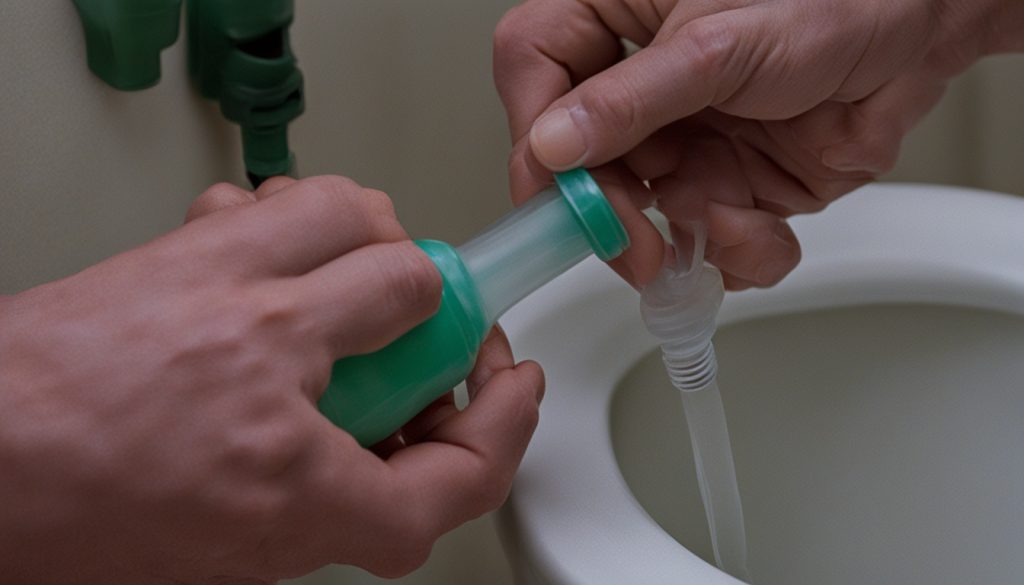During an enema, fluid is inserted into the rectum to soften stool and flush out the bowels. The time it takes for an enema to work can vary, but it typically starts to take effect within a few minutes.
However, it is important to note that individuals should stay near a toilet for approximately 1 hour as they may need to use the bathroom multiple times during this period. The effectiveness duration of an enema can vary depending on factors such as the type of fluid used, the volume of the contents, and the retention period.
Enemas are used for various purposes, including administering medication, treating constipation or other bowel conditions, and preparing for surgery or diagnostic examination. However, it is important to consult with a doctor before using an enema as individual needs and product suitability can vary.
Using an enema involves several steps. The enema fluid should be warmed in a bowl of warm water before starting. The nozzle should be inserted into the anus, and the contents should be slowly squeezed into the rectum. After removing the nozzle, it is recommended to lie flat on the back and try to keep the bowels closed for as long as possible to retain the fluid.
Enemas can contain different fluids depending on their purpose. Some common types of enemas include barium enemas, salt solution enemas, soap sud enemas, mineral oil enemas, coffee enemas, and warm water enemas. Each type has its own effects and usage.
Enemas serve various purposes and are used for different reasons. They can be used to administer medication, treat chronic constipation or other bowel conditions, and prepare for surgery or diagnostic examinations. Some individuals also use enemas regularly for general health benefits through detoxification.
While enemas can be safe and effective when used correctly, there are potential risks and complications associated with their use. It is important to follow healthcare provider’s instructions or package instructions when using an enema to minimize these risks.
In certain situations, it is important to seek medical attention when using an enema. If a person is unable to have a bowel movement after using an enema or experiences rectal bleeding, they should contact a doctor promptly.
To summarize, enemas can provide relief from constipation, administer medication, and assist in diagnostic procedures. The time it takes for an enema to work can vary, but it usually starts to take effect within a few minutes. It is important to consult with a healthcare provider before using an enema and to seek medical attention if any complications or adverse effects arise.
How to Use an Enema?
Using an enema involves several steps to ensure safe and effective administration. By following these enema insertion instructions, you can achieve optimal results:
- Begin by warming the enema fluid in a bowl of warm water. This helps to create a more comfortable experience.
- Remove the lid from the enema nozzle, ensuring it is clean and sterile. Optional: You can apply lubricating jelly to the nozzle for easier insertion.
- Lie down sideways on a towel, bringing your knees to your chest. This position helps to open up the rectum and facilitate the insertion process.
- Insert the nozzle approximately 7 centimeters into the anus, taking care not to force it. It’s important to go slowly and gently.
- Once the nozzle is in place, slowly squeeze the contents of the enema into the rectum. This gradual release allows the fluid to disperse effectively.
- After removing the nozzle, lie flat on your back and try to keep the bowels closed for as long as possible. This helps to retain the enema fluid and allows it to work effectively.
- When the urge to have a bowel movement arises, proceed to the bathroom. Stay near the bathroom for approximately 1 hour, as there may be a need to pass feces again.
- If you experience any complications or difficulties during the process, it is advisable to seek medical attention promptly.

Types of Enemas and Their Effects
Enemas are available in various types, each designed with specific purposes and effects. Understanding the different enema solutions and ingredients can help individuals choose the most suitable option for their needs.
1. Barium Enemas
Barium enemas are primarily used for diagnostic purposes. During a barium enema, a barium solution is inserted into the rectum to outline the large intestine for X-ray imaging. This procedure allows healthcare professionals to detect abnormalities, such as polyps or tumors, in the colon.
2. Salt Solution Enemas (Saline Enemas)
Salt solution enemas, commonly known as saline enemas, are frequently used for constipation relief. These enemas draw water into the bowels, softening the stool and promoting bowel movements. The salt solution helps restore proper hydration levels in the colon, aiding in the elimination of waste.
3. Soap Sud Enemas
Soap sud enemas involve a mixture of water and castile soap, which can effectively treat constipation. The soap acts as a lubricant, facilitating the passage of stool and easing discomfort. However, it is important to use mild soap and follow proper dilution guidelines to minimize the risk of irritation or damage to the rectal area.
4. Mineral Oil Enemas
Mineral oil enemas are another option for relieving constipation. The mineral oil lubricates the lower gastrointestinal tract, making it easier for stool to pass through. This type of enema can be particularly helpful for individuals with dry or hard stools.
5. Coffee Enemas
Coffee enemas involve the administration of coffee solution into the rectum. While some people claim benefits from coffee enemas, scientific evidence supporting their effectiveness is limited. It is important to note that coffee enemas may pose risks and complications and should be approached with caution.
6. Warm Water Enemas
Warm water enemas can be beneficial for addressing impacted fecal matter, especially in older adults who may have difficulty tolerating oral preparations for constipation. The warm water helps soften hardened stools and promote bowel movements.
It is crucial to consult with healthcare professionals before using any enema to ensure proper guidance and reduce the risk of adverse effects. Different enema solutions and ingredients may have varying effects on individuals, and a healthcare provider can offer personalized advice based on specific needs and conditions.
Uses and Purposes of Enemas
Enemas serve various purposes and are used for different reasons. They can be utilized to administer medication for conditions such as ulcerative colitis, treat chronic constipation or other bowel conditions, and prepare for surgery or diagnostic examinations like colonoscopy. Some individuals also regularly use enemas for general health benefits through detoxification.
Enemas are commonly employed in medical settings to administer medications directly into the rectum. This route of administration allows for rapid absorption of medications, bypassing the digestive system. Enemas can be particularly useful in managing certain gastrointestinal conditions, such as inflammatory bowel disease, by delivering targeted medication directly to the affected area.
Moreover, enemas can offer relief from chronic constipation. By introducing fluid into the rectum, enemas help to soften stool, making it easier to pass. This can be especially helpful for individuals who have difficulty with regular bowel movements. Enemas work by increasing hydration in the bowels, stimulating peristalsis, and promoting the elimination of waste.
In addition to their therapeutic uses, enemas are frequently utilized as part of the preparation process for surgeries and diagnostic procedures. By emptying the bowels, enemas provide healthcare professionals with a clear view of the colon during examinations like colonoscopy or to prepare for surgical interventions in the abdominal region.
Detoxification and Enemas
Some individuals incorporate enemas into their routine as a means of detoxification. The belief behind this practice is that enemas can help remove toxins and waste materials from the body, promoting overall health and well-being. However, it is important to note that the scientific evidence supporting the efficacy and safety of enemas for detoxification purposes is limited. The body has its own natural detoxification systems, primarily the liver and kidneys, which eliminate waste and toxins. Consulting with a healthcare provider before using enemas for detoxification purposes is essential to ensure appropriateness and safety.
Proper administration and adherence to instructions are vital to the safe and effective use of enemas. It is important to consult with a healthcare provider before using an enema, as individual needs and product suitability can vary. Healthcare professionals can provide guidance on the appropriate type of enema, the volume of the solution, and the duration of retention.

Safety and Potential Risks of Enemas
While enemas can be safe and effective when used correctly, it is important to be aware of the potential risks and complications associated with their use. Improper administration or overuse of enemas can lead to various complications, including:
- Bowel perforation
- Electrolyte imbalances
- Dehydration
- Infection
To minimize these risks, it is crucial to follow the instructions provided by healthcare providers or those found on the enema package. Proper technique and dosage are essential for safe usage.
It is important to note that certain types of enemas, such as coffee enemas or homemade enemas with ingredients like soapsuds or hydrogen peroxide, may not be safe or effective. These enemas should be avoided, as they can increase the risk of complications.
If any complications or serious side effects occur after using an enema, it is recommended to seek medical attention immediately. Prompt medical care can help address any potential issues and ensure your well-being.
Remember, enemas should always be used as directed and under the guidance of a healthcare professional.
When to Seek Medical Attention?
In certain situations, it is important to seek medical attention when using an enema. While enemas can be a safe and effective method for various purposes, there are potential complications and adverse effects that may arise. It is crucial to be aware of the signs that indicate the need to call a doctor.
- If a person is unable to have a bowel movement after using an enema, it is recommended to contact a doctor promptly. This could indicate an underlying issue that requires medical attention.
- Rectal bleeding after using an enema is another sign that should not be ignored. It is essential to consult a healthcare provider to determine the cause of the bleeding and to ensure appropriate treatment.
- Other signs that may indicate the need for medical attention include increased thirst, dizziness, decreased urination, vomiting, drowsiness, and swelling in the ankles, feet, or legs. These symptoms could be indicative of complications or adverse effects related to the enema.
- Individuals with pre-existing conditions such as kidney or heart conditions should consult a healthcare provider before using an enema. These individuals may be at a higher risk of experiencing adverse effects.
- Older adults should also seek medical advice before using an enema. Due to age-related factors and potential complications, it is important to ensure the proper administration and safe usage of enemas in this population.
Seeking medical attention when necessary is crucial for ensuring the safety and well-being of individuals using enemas. It is always better to consult a healthcare provider to address any concerns, complications, or adverse effects that may arise during or after the use of an enema.

Conclusion
Enemas can be a useful tool for providing relief from constipation, administering medication, and facilitating diagnostic procedures. They typically start to take effect within a few minutes of administration, but the time may vary depending on individual factors. Proper administration and adherence to instructions are essential for the safe and effective use of enemas.
While enemas can be safe when used correctly, it is important to be aware of potential risks and complications. Incorrect or excessive use of enemas can lead to bowel perforation, electrolyte imbalances, dehydration, and infection. Care should be taken to consult with a healthcare provider before using an enema and to seek medical attention if any complications or adverse effects arise.
In summary, enemas offer benefits for various purposes, but caution should be exercised to ensure their safe use. Consultation with a healthcare professional is crucial to determine the appropriateness of an enema for individual needs. By understanding their effectiveness, following proper guidelines, and being aware of safety considerations, individuals can make informed decisions regarding the use of enemas.




